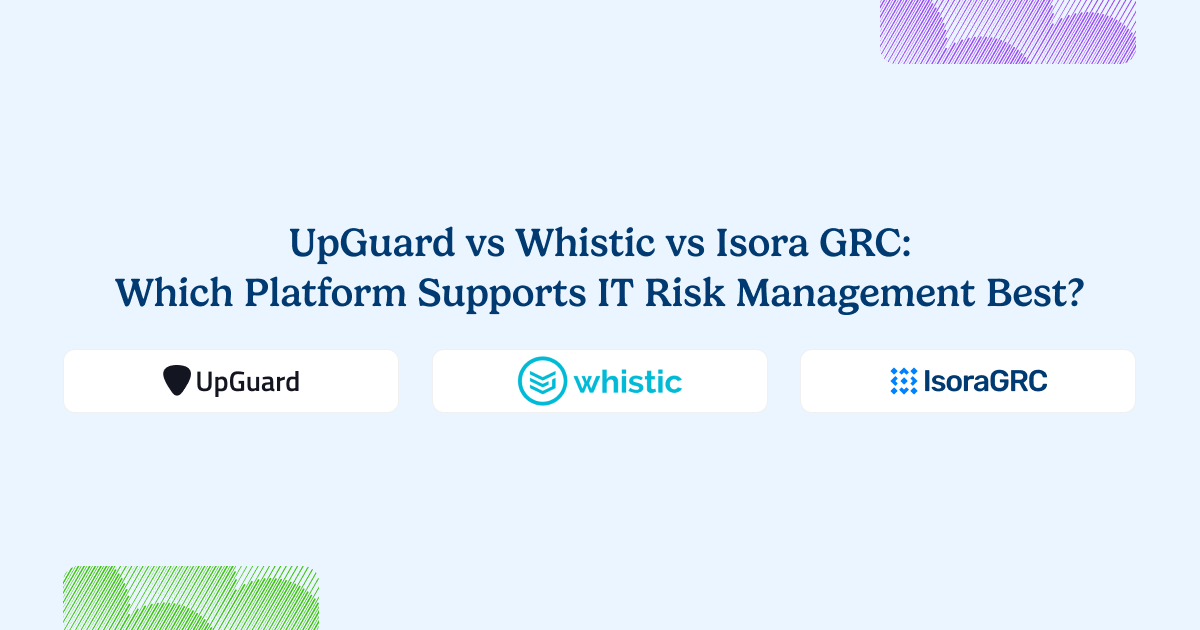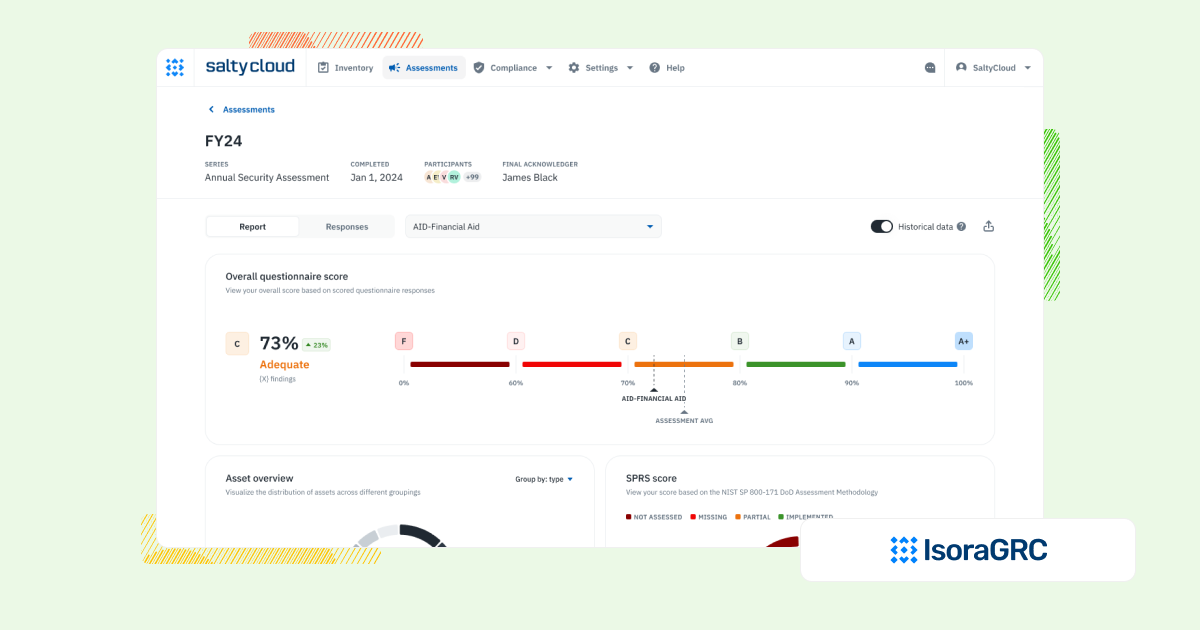
Every security team needs a practical, scalable way to manage IT risk—not just rely on external vendor ratings.
Platforms like UpGuard and Whistic provide vendor intelligence, offering external scores to highlight potential risks within your third-party relationships.
External scores can highlight issues, but they don’t help you assess, track, or resolve risks in a structured and actionable way.
Isora GRC takes a different approach. It’s purpose-built for security teams who need to run assessments, manage inventories, and track risks—moving beyond vendor scores to provide a full, actionable risk management solution.
Let’s take a more careful look.
Choosing the Right Platform for IT Risk Management
UpGuard and Whistic are both focused on third-party risk, but their functionality tends to center around surface-level reviews and document sharing.
They work well for storing vendor profiles or exchanging security documentation, but they often lack the workflows necessary to fully evaluate vendor risk or tie assessments to the organization’s broader IT risk strategy.
Isora GRC delivers what those platforms lack: structured third-party and internal risk workflows that scale across departments and vendor ecosystems. With Isora, teams can issue detailed assessments, manage evidence collection, conduct internal reviews, and maintain a centralized, auditable risk register.
The platform also enables collaboration between risk owners and stakeholders—so vendor risk becomes an integrated part of your larger program, not an isolated checklist.
The Workflow That Matters: Managing IT Risks and Compliance
Managing vendor risk requires more than uploading documents to a portal. Security teams must assess vendors directly, understand how those vendors interact with internal systems, and follow up on any risks or control gaps identified during review.
Isora GRC supports these essential workflows by allowing teams to issue questionnaires, manage vendor responses, log and resolve exceptions, and generate reports that reflect actual risk posture—not just static inputs.
With repeatable assessment cycles and automated reminders, you can establish continuous visibility into your vendor landscape, instead of one-off point-in-time reviews.
How Each Platform Supports IT Risk Management Workflows
| Workflow Area | UpGuard | Whistic | Isora GRC |
| Assessment Management | UpGuard offers strong tools for assessments, security ratings, and leak detection. Still, some users say it takes time to learn the platform. | Whistic focuses on security checks. It lacks wider tools found in full GRC systems. Teams needing more depth may feel restricted. | Centralized, intuitive assessment dashboard across business units, vendors, and assets. Built specifically for security teams. |
| Questionnaire Delivery & Completion | The system handles questionnaires well. But users wanting deep customization might feel limited. | Survey tools in Whistic work well for speed. Still, options stay limited for deep changes. Some users may struggle to match forms with exact needs. | Customizable and prebuilt questionnaires for frameworks like NIST, ISO, GLBA, HIPAA, and more. Designed for internal and external collaboration. |
| Inventory Tracking | UpGuard checks vendors and their security levels. Still, full asset tracking is not the main focus. | Whistic skips inventory tracking. The main goal stays with assessments. Teams needing asset tracking must look elsewhere. | Centralized tracking of assets, vendors, and organizational units with integration support for existing data sources. |
| Risk Register & Exception Management | Risk tools exist, but advanced features may need expert help. Less technical users could struggle. | Whistic helps with security checks but misses a full risk log and strong exception tools. Teams needing full risk support may feel gaps. | Flexible, collaborative risk register with scoring, status, evidence, and ownership tied directly to assessments. Exception management is built-in and intuitive—no extra modules or configuration required. |
| Scoring, Reporting & Risk Visualization | UpGuard includes security scores and reports. However, risk visuals may feel basic to some users. | Whistic scores and reports well for security tasks. For deeper charts or advanced insights, users may find limits. | Automated scorecards, risk maps, and executive-friendly reports with actionable insights—no manual config required. |
| Collaboration & User Experience | The platform works well for tech users. But learning to use the collaboration tools may take time. | Using Whistic feels smooth, especially for security tasks. Teamwork tools work but stay simple. Bigger platforms may offer more. | WCAG-compliant, award-nominated interface with built-in commenting, team workflows, and fast onboarding. |
| Implementation & Setup | UpGuard needs time and resources to set up. Teams may need training and support for smooth use. | Starting with Whistic feels easy for teams focused on security. For wider GRC needs, some may feel the tool does not cover enough. | No-code setup in days or weeks. Minimal IT lift required. Designed to go live quickly across teams and vendors. |
What Sets Isora GRC Apart?

Isora GRC was purpose-built for information security teams—designed to support the real workflows behind risk and compliance, not just generate reports. While legacy GRC platforms require months of configuration and rigid processes, Isora takes a modern, scalable approach:
- Purpose-built for security and third-party risk teams
- No extra modules or cross-department bloat—just the workflows that matter.
- Easy for anyone to use
- Clean UI, no complex training, and built to drive adoption across the org.
- Streamlined for action, not just documentation
- Assessments, questionnaires, inventories, risk tracking, and reporting—all in one place.
- Fast, no-code implementation
- Go live in weeks, not quarters, with minimal IT lift.
- Scales with your program
- Whether you’re running a lean risk function or supporting a large institution, Isora grows with you—without getting in the way.
Who Each Platform Is Best For
| Platform | Who It’s For |
| UpGuard | Getting a quick view of vendor security from the outside. Helpful info, but not a full-risk solution. |
| Whistic | Teams focused only on vendor reviews. Great for third-party risk, but not a full GRC program. |
| Isora GRC | Security teams that need a scalable, usable IT risk management program across their organization. |
What Our Customers Say About Isora GRC
Security teams at top institutions are using Isora GRC to replace legacy tools and manual processes with intuitive workflows and actionable insight.
“Moving from manual processes to using Isora was a breath of fresh air. What used to take months is now automated, reliable, and defensible. Isora saves us significant time while delivering accurate insights that improve decision-making.”
Jessica Sandy, IT GRC Manager, The University of Chicago
“Isora has been essential in helping us meet our University of California cybersecurity requirements across a decentralized campus. Automating assessment data collection and reporting has given us clear visibility into unit-level risks, enabling us to prioritize resources effectively and address gaps with confidence.”
Allison Henry, CISO, The University of California, Berkeley
FAQs
What’s the difference between UpGuard, Whistic, and Isora GRC?
UpGuard and Whistic specialize in third-party risk assessments, often focusing on security questionnaires and vendor profiles. Isora GRC supports broader workflows—combining internal and third-party assessments, vendor and asset inventories, exception tracking, and a centralized risk register.
Are UpGuard and Whistic considered full GRC platforms?
No. They are primarily third-party risk management tools. While they support vendor assessments and profiles, they don’t manage internal security assessments, broader risk registers, or exception workflows across the organization like Isora GRC does.
Does Isora GRC replace tools like UpGuard or Whistic?
Yes. Isora GRC supports the full third-party risk lifecycle, including customizable questionnaires (e.g., HECVAT, SIG), vendor tracking, remediation workflows, and internal collaboration—all within one platform.
Which platform is better for managing both internal and third-party risk?
Isora GRC. It enables teams to assess vendors and internal units alike, tie findings to inventories, track exceptions, and maintain a living risk register—while UpGuard and Whistic are more limited to external vendor workflows.
Can Isora GRC be used alongside UpGuard or Whistic?
Yes. Some teams use Whistic or UpGuard for vendor profile sharing or lightweight assessments, while managing operational and enterprise-wide risk through Isora GRC.
What should I look for in a third-party risk management platform?
Look for support for standardized and custom assessments, exception management, vendor and asset inventories, and integrated risk tracking. Isora GRC delivers these capabilities in one platform that scales across the organization.


















